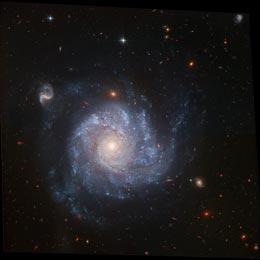Aliens might have sent messages by tweaking variable stars.
 Galaxy NGC 1309, snapped by the Hubble Space Telescope, is packed with Cepheid stars of the type that could form a communication network.NASA, The Hubble Heritage Team and A. Riess (STScI)
Galaxy NGC 1309, snapped by the Hubble Space Telescope, is packed with Cepheid stars of the type that could form a communication network.NASA, The Hubble Heritage Team and A. Riess (STScI)Just by gazing at the stars, earthling astronomers might have unwittingly picked up broadcasts from extraterrestrial civilizations. So says a neutrino physicist, adding that it might take researchers just a few months of searching to find evidence of this alien internet.
John Learned at the University of Hawaii in Honolulu and his colleagues think that signals could be sent by manipulating Cepheid variable stars. These rare stars can be seen in other galaxies more than 60 million light years from our own.
Cepheids dim and brighten regularly, in a pattern that depends on their brightness. This lets astronomers measure the distance to the stars, helping to resolve mysteries such as the Universe's age and how fast it is expanding. As such, any sufficiently advanced civilization would want to monitor such stars, the scientists reasoned.
To send messages using a Cepheid, Learned and his colleagues suggest that extraterrestrials might change the star's cycle. A Cepheid becomes dimmer as ionized helium builds up in its atmosphere. Eventually, the atmosphere expands and deionizes, restarting the cycle.
Firing a high-energy neutrino beam into a Cepheid could heat its core and brighten the star early — "just as an electric pulse to the heart can make it skip a beat," Learned says.
The neutrinos could be made by blasting a proton beam at a target — sapphire, carbon or tungsten would work, says Learned. The target produces subatomic particles, mostly pions, which decay to produce neutrinos.
The normal and shortened pulses could be used to encode data, to form what the researchers call a 'galactic Internet' in a paper posted to the arXiv preprint server1.
Low bandwidth
"It's an interesting idea that can be tested — somebody should look at the archives on these stars and see if there are any light variations of the kind they are describing," says physicist Freeman Dyson of the Institute for Advanced Study in Princeton, New Jersey.
Adds Seth Shostak, senior astronomer at the SETI (Search for Extraterrestrial Intelligence) Institute in Mountain View, California: "It's a great idea, reminiscent of an old Russian idea about bouncing high-energy radiation off the 100 or 200 real supergiant stars in the galaxy to generate anomalous radiation as signals others could see."
Learned admits that the galactic internet would be slow — a Cepheid with a roughly one-day period could transmit about 180 bits per year. Such a transmission would require roughly a millionth of the star's energy, the researchers estimate.
"A millionth of a star's output is a heck of a lot of energy," says Shostak, adding that a high-powered radio beacon could probably transmit more data over similar distances.
Learned says that finding a signal from the galactic internet is a long shot — but, he says, we've got 100 years of data on Cepheids in which to look.
"Analyzing that data would take a graduate student a couple of months, and just think if it turned out to be correct," says Learned. "The implications would be astounding."









